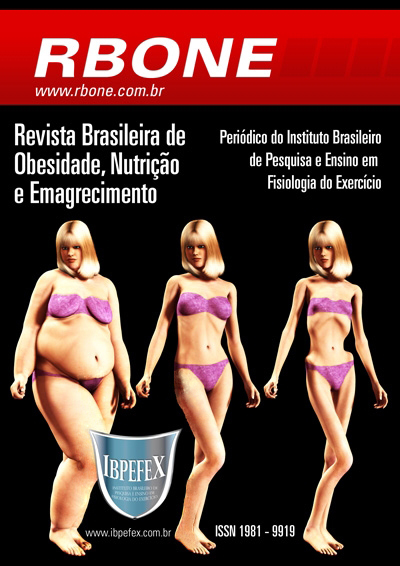Consumption of sodium-rich foods and others risk factors for patientes with systemic arterial hypertension treated at a nutrition clinic
Abstract
Objective: To analyze the consumption of foods rich in sodium and other risk factors in hypertensive patients treated at an outpatient clinic of nutrition. Materials and Methods: We evaluated data socioeconomic, anthropometric and dietary habits related to health, as the practice of physical exercise, intestinal function and food consumption. Also, were calculated in the period, the percentages of weight loss and loss of excess weight and related to the intervention time and the number of consultations in the period. Results: the excessive consumption of foods rich in sodium by hypertensive patients was less than one-third. The prevalence of risk factors such as sedentary lifestyle, overweight and increased risk for the development of metabolic complications. There was a significant improvement in these parameters except the neck circumference in hypertensive patients. In general, there has been a significant improvement in the consumption of healthy foods, although the majority of consumption has remained below recommended levels. Conclusion: nutritional care is important to improve the consumption of foods rich in sodium and healthy foods, although the majority of consumption of healthy foods by hypertensive patients has remained below recommended levels.
References
-Alvarez, T.S.; Zanella, M.T. Impacto de dois Programas de Educação Nutricional sobre o Risco Cardiovascular em Pacientes Hipertensos e com Excesso de Peso. Revista de Nutrição. Vol. 22. Num. 1. 2009. P.71-79.
-Ferreira, S.R.G.; Moura, E.C.; Malta, D.C.; Sarno, F. Frequência de Hipertensão Arterial e Fatores Associados. Revista de Saúde Pública. Vol. 43. Supl. 2. 2009. p:98-106.
-Frizon, V.; Boscaini, C. Circunferência do pescoço, fatores de risco para doenças Revista Brasileira de Cardiologia. Vol. 26. Num. 6. 2013. P. 426-34
-Granella, E.C.; Volkweis, D.S.H.; Soder, T.F.; Pinheiro, T.L.F.; Benetti, F. Prevalência de hipertensão arterial em pacientes atendidos no ambulatório de nutrição da URI - Frederico Westphalen. Nutrição Brasil. Vol. 17. Num. 1. 2018. p.19-26.
-Malta, D.C.; Gonçalves, R.P. F.; Machado, I.M.; Freitas, M.I.F.; Azeredo, C.; Szwarcwald, C.L. Prevalência da Hipertensão Arterial Segundo Diferentes Critérios Diagnósticos, Pesquisa Nacional em Saúde. Revista Brasileira de Epidemiologia. Vol. 21. Supl.1. 2018.
-Menezes, M.H.; Reis, V.H.S.; Dantas, D.B.D.; Santana, A.P.; Dias, F.C.S.; Rodrigues Junior, C.A.; Cuellar, P.M.G. Hipertensão arterial sistêmica e eventos cardiovasculares no Estado do Tocantins, brasil. Revista de Patologia do Tocantins. Vol. 4. Num. 2. 2017.
-Ministério da Saúde. Guia alimentar para a População Brasileira. Brasília-DF. Ministério da Saúde. 2014.
-Ministério da Saúde. Instituto Brasileiro de Geografia e Estatística. Ministério do Planejamento, Orçamento e Gestão. Pesquisa Nacional de Saúde: 2013. Percepção do estado de saúde, estilos de vida e doenças crônicas. Brasil, grandes regiões e unidades da federação [Internet]. Rio de Janeiro: Instituto Brasileiro de Geografia e Estatística. 2014.
-Machado, J.C.; Cotta, R.M.M.; Moreira, T.R.; Silva, L.S. Análise de três Estratégias em Saúde para Portadores de Hipertensão Arterial. Ciência e Saúde Coletiva. Vol. 21. Num. 2. 2016. P. 611-620.
-OMS. Organização Mundial da Saúde. Organização Pan Americana da Saúde. 2016.
-Piccini, R.X.; Thumé, E.; Silva, S.M.; Dilelio, A.S. Promoção e Prevenção e Cuidado da Hipertensão Arterial no Brasil. Revista de Saúde Pública. Vol. 46. Num. 3. 2012. P.543-550.
-Pitanga, F. J. G; Lessa, I.; Sensibilidade e especificidade do índice de conicidade como discriminador do risco coronariano de adultos em Salvador, Brasil. Revista Brasileira de Epidemiologia. Vol. 7. Num. 3. 2004.
-Sarno, F.; Claro, R.M.; Levy, R.B.; Bardoni, D.H.; Monteiro, C.A. Estimativa de Consumo de Sódio pela população Brasileira. Revista de Saúde Pública. Vol. 47. Num.3. 2013. p: 571-578. 2013.
-SBC. Sociedade Brasileira de Cardiologia. 7a Diretriz Brasileira de Hipertensão Arterial. Arquivos Brasileiros de Cardiologia. Vol. 107. supl. 3. 2016.
-Souza, A.M.; Souza, B.S.N.; Bezerra, I.N.; Sichieri, S. Impacto da Redução de Sódio em Alimentos Processados no Consumo de Sódio no Brasil. Cadernos de Saúde Pública. Vol. 32. Num. 2. 2016.
-Teixeira, E.R.; Lamas, A.R.; Costa e Silva, J.; Matos, R.M. O Estilo de Vida do Cliente com Hipertensão Arterial. Revista de Enfermagem. Vol. 10. Num. 3. 2006. p:378-384.
-Uarthe, B. M.; Pretto, A. D. B.; Massaut, K. B.; Colvara, Y. P.; Diniz, M. A.; Pacheco, F. B.; Moreira, Â. N. Avaliação do índice de conicidade como preditor de risco cardiometabólico e suas associações em pacientes adultos submetidos a atendimento ambulatorial no Sul do Brasil. Semina: Ciências Biológicas e da Saúde. Vol. 40. Num. 2. 2019.
-Valdez, R.; Seidell.; J.C.; Ahn, Y.I.; Weiss, K.M. A new index of abdominal adiposity as an indicator of risk for cardiovascular disease. International Journal of Obesity. Vol. 17. Num. 2. 1993. p.77-88.
Copyright (c) 2022 Lucélia Garcia Soares, Vanessa Mota Teixeira, Alessandra Doumid Borges Pretto, Bruna Martins Uarthe, Yanne Pereira Colvara, Adriana Pereira Teles, Lucas de Alvarenga Furtado, Nathalia Alves Specht, Larissa Sander Magalhães, Angela Nunes Moreira

This work is licensed under a Creative Commons Attribution-NonCommercial 4.0 International License.
Authors who publish in this journal agree to the following terms:
- Authors retain the copyright and grant the journal the right of first publication, with work simultaneously licensed under the Creative Commons Attribution License BY-NC which allows the sharing of the work with acknowledgment of the authorship of the work and initial publication in this journal.
- Authors are authorized to enter into additional contracts separately for non-exclusive distribution of the version of the work published in this journal (eg, publishing in institutional repository or book chapter), with acknowledgment of authorship and initial publication in this journal.
- Authors are allowed and encouraged to post and distribute their work online (eg, in institutional repositories or on their personal page) at any point before or during the editorial process, as this can bring about productive change as well as increase impact and impact. citation of published work (See The Effect of Free Access).






